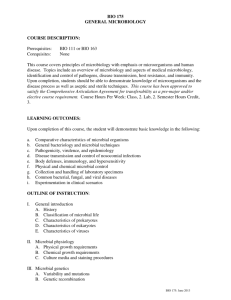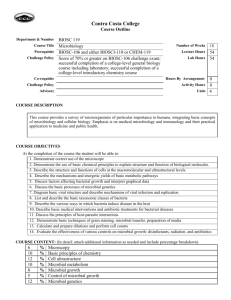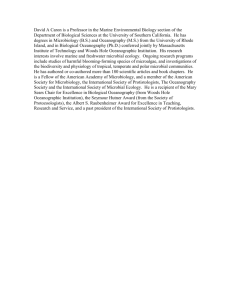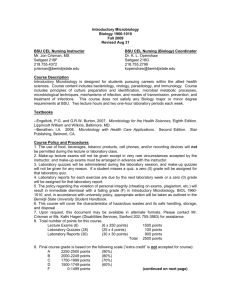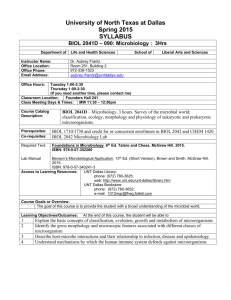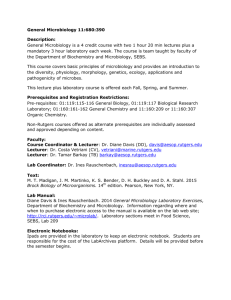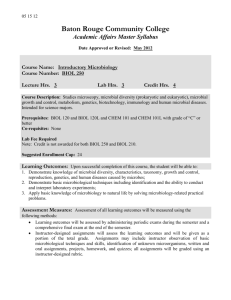General Microbiology - Faculty of Agriculture
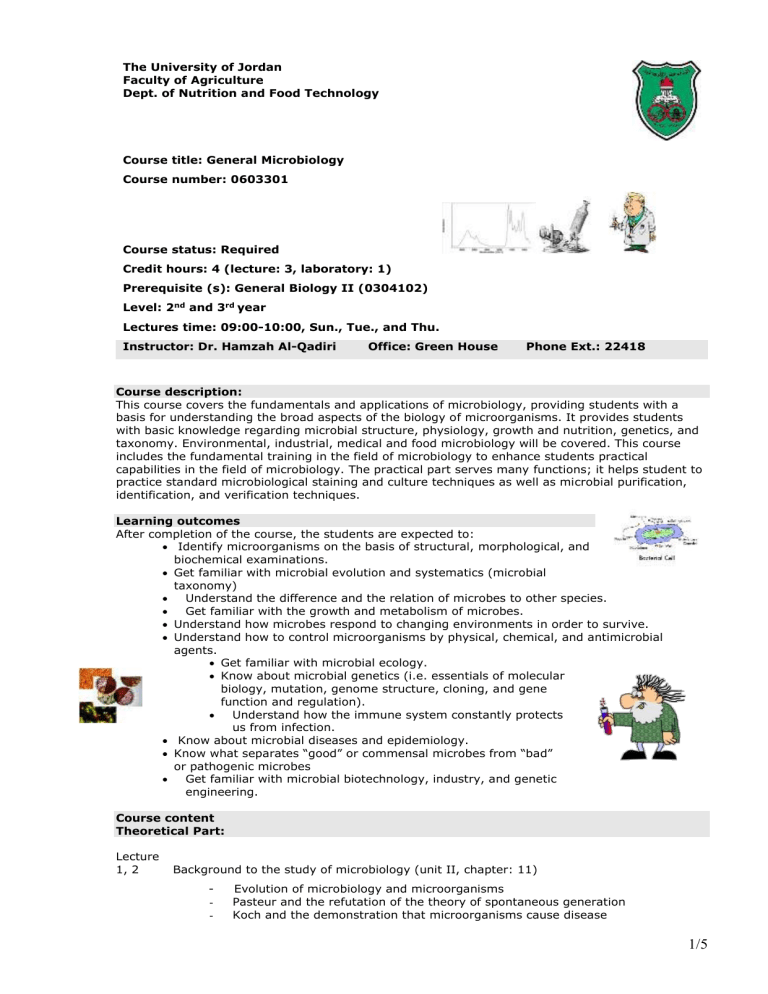
The University of Jordan
Faculty of Agriculture
Dept. of Nutrition and Food Technology
Course title: General Microbiology
Course number: 0603301
Course status: Required
Credit hours: 4 (lecture: 3, laboratory: 1)
Prerequisite (s): General Biology II (0304102)
Level: 2 nd and 3 rd year
Lectures time: 09:00-10:00, Sun., Tue., and Thu.
Instructor: Dr. Hamzah Al-Qadiri Office: Green House Phone Ext.: 22418
Course description:
This course covers the fundamentals and applications of microbiology, providing students with a basis for understanding the broad aspects of the biology of microorganisms. It provides students with basic knowledge regarding microbial structure, physiology, growth and nutrition, genetics, and taxonomy. Environmental, industrial, medical and food microbiology will be covered. This course includes the fundamental training in the field of microbiology to enhance students practical capabilities in the field of microbiology. The practical part serves many functions; it helps student to practice standard microbiological staining and culture techniques as well as microbial purification, identification, and verification techniques.
Learning outcomes
After completion of the course, the students are expected to:
Identify microorganisms on the basis of structural, morphological, and biochemical examinations.
Get familiar with microbial evolution and systematics (microbial taxonomy)
Understand the difference and the relation of microbes to other species.
Get familiar with the growth and metabolism of microbes.
Understand how microbes respond to changing environments in order to survive.
Understand how to control microorganisms by physical, chemical, and antimicrobial agents.
Get familiar with microbial ecology.
Know about microbial genetics (i.e. essentials of molecular biology, mutation, genome structure, cloning, and gene function and regulation).
Understand how the immune system constantly protects us from infection.
Know about microbial diseases and epidemiology.
Know what separates “good” or commensal microbes from “bad” or pathogenic microbes
Get familiar with microbial biotechnology, industry, and genetic engineering.
Course content
Theoretical Part:
Lecture
1, 2 Background to the study of microbiology (unit II, chapter: 11)
- Evolution of microbiology and microorganisms
-
Pasteur and the refutation of the theory of spontaneous generation
-
Koch and the demonstration that microorganisms cause disease
1/5
3, 4, 5 Cell structure and function (unit I, chapters: 4, 7, 9)
6, 7, 8,
9, 10
-
External structures that protect the cells
-
Cytoplasmic membrane, movement of materials into and out of cells
-
Cellular storage of Genetics information
-
Structures involved with motility of cells
-
Survival through the production of spores
Classification of microorganisms (unit II, chapters: 12, 13, 14, 15,
16, unit I, chapter 9)
Prokaryotic diversity: the bacteria
-
Nomenclature
-
Classification of bacterial cells
-
Identification of bacterial cells
-
The major groups of bacteria
Prokaryotic diversity: the Archaea
Eukaryotic microbial diversity (Survey of fungi, algae, and protozoa)
Microbial genomics
Viruses
-
Viruses of prokaryotes
-
Viruses of eukaryotes
Microbial growth and metabolism (unit I, chapters: 3, 5, 6, 8) 11, 12,
13, 14,
15
Macromolecules
Nutrition, laboratory culture, and metabolism of microorganisms
Microbial Growth (bacterial growth)
-
Kinetics of bacterial growth
-
Growth curve of bacteria
-
Batch and continuous culture of bacteria
Influence of environmental factors on the growth of microorganisms
Metabolic regulations
Biosynthesis of macromolecules
Microbial energetics (the generation of ATP)
-
Enzymes and microbial metabolism
-
Heterotrophic generation of ATP
-
Autotrophic generation of ATP
Mid-term exam
Metabolic diversity and microbial ecology (unit III, chapters: 17, 18, 19)
16
17, 18,
19
Metabolic diversity
Microbial ecology
Methods in microbial ecology
Microbial genetics (unit 1, chapters: 7, 10; unit II, chapter 15) 20, 21,
22, 23
Gene and gene expression
DNA structure
DNA replication
RNA synthesis (transcription)
Protein synthesis
Genetic variation
-
Mutation and DNA recombination
-
Genome structure
-
Genetic exchange in prokaryotes
-
Gene cloning and genomic cloning techniques
-
Bacterial chromosome
-
Gene function and regulation
24, 25 Control of microorganisms (Unit IV, chapter: 20)
26, 27,
28
Physical antimicrobial control
Chemical antimicrobial control
Antimicrobial agents used in vivo
Immunology, pathogenicity, and host responses (Unit IV, chapters: 21, 22)
Essential of immunology
Microbial interactions with human
2/5
29, 30,
31
Microbial diseases (unit V, chapters: 25, 26, 27)
Epidemiology
Person-to- person microbial disease
Animal-transmitted diseases
32, 33 Environmental microbiology (unit V, chapters: 28, 29)
34, 35,
36
Soil and air microbiology
Waterborne microbial diseases
Food preservation and foodborne microbial diseases
Microorganisms as tools for industry and research (unit VI, chapters: 30, 31)
Biotechnology and industrial microbiology
Genetic engineering of microorganism
Representative FT-IR spectral patterns of L. innocua
ATCC 51742. νas = asymmetric stretch,
νs = symmetric stretch, δs = symmetric deformation
Practical Part:
1 - Safety measures in the microbiological laboratory
- Types of microscopes
The approximate composition of a typical bacterial cell (weight basis). (Alberts et al., 2002).
3/5
2 Sterilization techniques
- Physical methods
-
Heat
-
Radiation
-
Membrane filtration
- Chemical reagents
3 Growing of microorganisms
- Preparation of culture media (broth and agar)
- Preparation of pure culture
-
Streaking method
-
Slant and stabbing techniques
4 Microscopy and staining (1)
-
Preparation of slides
-
Motility test (hanging drop technique)
-
Examination of unstained living organisms
-
Simple stain
5 Microscopy and staining (2)
-
Gram stain
-
Spore stain
6 Microbial physiology and biochemical tests (1)
-
Oxidase test
-
Catalase test
-
Oxidation/fermentation test
7 Microbial physiology and biochemical tests (2)
-
Carbohydrate metabolism
-
Protein metabolism
-
Starch hydrolysis
-
Casein hydrolysis
-
Urea hydrolysis
8 Characterization of molds
9 Characterization of yeasts
10 Studying viruses
11 Conditions affecting microbial growth (1)
- Microorganism of extreme conditions
-
Halotolerant
-
Acid tolerant
-
Thermotolerant
12 Conditions affecting microbial growth (2)
-
Nutrient requirements
-
Oxygen requirement (aerobic, anaerobic, and fermentation reactions)
13 Enumeration of microorganisms
-
Direct microscopic count (counting chambers)
-
Pour plate method
-
Spread plate method
Grade distribution and exam time
Exam
Mid-term theory exam
%
25
Mid-term lab exam
Final theory exam
10
35
Date
4/5
Final lab exam
Other Activities
Reports and quizzes
15
%
10
Homework, assignment, and class activity
5
Learning Resources
Required text book:
1 Title
Author
Brock Biology of Microorganisms
Madigan, Martinko
Publisher Prentic Hall
Edition 11th ed., 2006
Recommended references:
1 Title
Author
Microbiology, Fundamentals and Applications
Ronald M. Atlas
Publisher
Edition
2 Title
Author
Publisher
Edition
3 Title
Author
Macmillan Publishing Company, Collier Macmillan Publishers
2nd ed., 1988
Molecular Biology of the Cells
Alberts, johnson, Lewis, Raff, Roberts, and Walter
Garland Science
4th ed., 2002
Fundamentals of Microbiology
Pommerville
Edition
4 Title
Author
Publisher
Edition
5 Internet :
7th ed.
Control of Communicable Diseases Manual
James Chin
American Public Health Association
17th ed., 2000
-
American Society for Microbiology (ASM) ( www.asm.org
)
-
Centers for Disease Control and Prevention (CDC) ( www.cdc.gov
)
-
American Public Health Association (APHA) ( www.apha.org
)
-
World Health Organzation (WHO) ( www.who.org
)
5/5

